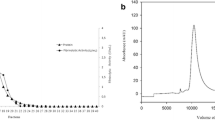Abstract
A novel fibrinolytic enzyme from Rhizopus chinensis 12 was purified through ammonium sulfate precipitation, hydrophobic interaction, ionic exchange, and gel filtration chromatography. The purification protocol resulted in a 893-fold purification of the enzyme, with a final yield of 42.6%. The apparent molecular weight of the enzyme was 18.0 kDa, determined by sodium dodecylsulfate-polyacrylamide gel electrophoresis, and 16.6 kDa by gel filtration chromatography, which revealed a monomeric form of the enzyme. The isoelectric point of the enzyme estimated by isoelectric focusing electrophoresis was 8.5±0.1. The enzyme hydrolyzed fibrin. It cleaved the α, β, and γ chains of fibrinogen simultaneously, and it also hydrolyzed casein and N-succinyl-Ala-Ala-Pro-Phe-pNA. The enzyme had an optimal temperature of 45°C, and an optimal pH of 10.5. EDTA, PCMB, and PMSF inhibited the activity of the enzyme, and SBTI, Lys, TPCK, and Aprotinine had no obvious inhibition, which suggested that the activity center of the enzyme had hydrosulfuryl and metal. The first 12 amino acids of the N-terminal sequence of the enzyme were S-V-S-E-I-Q-L-M-H-N-L-G and had no homology with that of other fibrinolytic enzyme from other microbes.





Similar content being viewed by others
References
Andrews P (1965) The gel-filtration behaviour of proteins related to their molecular weights over a wide range. Biochem J 96:596–606
Astrup T, Mullertz S (1952) The fibrin plate method for estimating fibrinolytic activity. Arch Biochem Biophys 40:346–351
Chang CT, Fan MH, Kuo FC, Sung HY (2000) Potent fibrinolytic enzyme from a mutant of Bacillus subtilis IMR-NK1. J Agric Food Chem 48:3210–3216
Du LX, Jia SJ, Lu FP (2003) Morphological changes of Rhizopus chinensis 12 in submerged culture and its relationship with antibiotic production. Process Biochem 38:1643–1646
Fujita M, Nomura K, Hong K, Ito Y, Asada A, Nishimuro S (1993) Purification and characterization of a strong fibrinolytic enzyme (nattokinase) in the vegetable cheese natto, a popular soybean fermented food in Japan. Biochem Biophys Res Commun 197:1340–1346
Kim S, Choi N (2000) Purification and characterization of subtilisin DJ-4 secreted by Bacillus sp. strain DJ-4 screened from Doen-Jang. Biosci Biotechnol Biochem 64:1722–1725
Kim W, Chol K, Kim Y, Park H, Chol J, Lee Y, Oh H, Kwon I, Lee S (1996) Purification and characterization of a fibrinolytic enzyme produced from Bacillus sp. strain CK 11-4 screened from Chungkook-Jang. Appl Environ Microbiol 62:2482–2488
Kim HK, Kim GT, Kim DK, Choi WA, Park SH, Jeong YK, Kong IS (1997) Purification and characterization of a novel fibrinolytic enzyme from Bacillus sp. KA38 originated from fermented fish. J Ferment Bioeng 84:307–312
Koh YS, Chung KH, Kim DS (2001) Biochemical characterization of a thrombin-like enzyme from snake. Toxcion 39:555–560
Laemmli UK (1970) Cleavage of structural proteins during the assembly of the head of bacteriophage T4. Nature 227:680–686
Lowry OH, Rosebrough NJ, Farr AL, Randall RJ (1951) Protein measurement with the Folin phenol reagent. J Bio Chem 193:264–275
Nakajima N, Taya N, Sumi H (1993) Potent fibrinolytic enzyme from the lysate of Katsuwonus pelamis digestive tract (shiokara): purification and characterization. Biosci Biotechnol Biochem 57:1604–1605
Miyata K, Hira S, Yashiki T, Tomoda K (1980) Intestinal absorption of Serratia protease. J Appl Biochem 2:111–116
Sumi H, Hamada H, Nakanishi K, Hiratani H (1990) Enhancement of the fibrinolytic activity in plasma by oral administration of NK. Acta Haematol 84:139–143
Sumi H, Hamada H, Tsushima H, Mihara H, Muraki H (1987) A novel fibrinolytic enzyme (nattokinase) in the vegetable cheese natto, a typical and popular soybean food in the Japanese diet. Experientia 43:1110–1111
Papp M, Feher S, Folly G, Horvath EJ (1977) Absorption of pancreatin lipase from the duodenum into lymphatics. Experientia 33:1191–1192
Warshaw AL, Walker WA, Isselbacher KJ (1974) Protein uptake by the intestine: evidence of absorption of intact macromolecules. Gastroenterology 66:987–992
Acknowledgements
This work was supported by Nature Science Fund of Tianjin City (023803411), the Nature Science Fund of Heilongjiang Province (D0228), and a teacher fund of Heilongjiang Province Education Bureau.
Author information
Authors and Affiliations
Corresponding author
Rights and permissions
About this article
Cite this article
Xiao-lan, L., Lian-xiang, D., Fu-ping, L. et al. Purification and characterization of a novel fibrinolytic enzyme from Rhizopus chinensis 12. Appl Microbiol Biotechnol 67, 209–214 (2005). https://doi.org/10.1007/s00253-004-1846-5
Received:
Revised:
Accepted:
Published:
Issue Date:
DOI: https://doi.org/10.1007/s00253-004-1846-5




